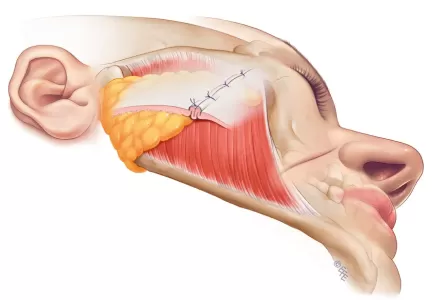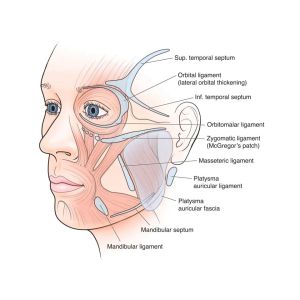Facelift techniques: find the technique that best suits your goal
And what about a Mini-Lift?
Why has the Deep Plane Facelift become so popular?
Is it the same as a Vertical Facelift?
If you’re considering a Facelift, you’ve probably come across different techniques and terms that may seem confusing.
The truth is, there’s a lot of noise (and a lot of marketing).
I’m Alejandro Mazarro, a maxillofacial surgeon specialized in Facelift.
As a facelift specialist with over 9 years of experience, I’ve tried them all—believe me.
And today, I’m absolutely clear on the best method for achieving natural rejuvenation: the Deep Plane Facelift.
But let me not jump ahead.
Let me explain the differences between the various techniques so you can see why it’s impossible to achieve the same results with other methods.
Let’s get started!
What is a facelift or a rhytidectomy?
A facelift, or rhytidectomy, is a surgical procedure designed to address facial sagging by repositioning the underlying tissues.
Whilst various techniques exist, only the most advanced approaches — such as the Deep Plane — can rejuvenate the face without compromising its natural expression. This isn’t about “pulling the skin tight”, but rather restoring facial structures to their youthful position for results that look natural and stand the test of time.
Facial Anatomy: The Foundations of a Facelift
To understand why some techniques are a waste of time whilst others deliver extraordinary results, it’s essential to grasp the fundamentals of facial anatomy.
There are two key structures that are crucial for understanding what happens with ageing and why traditional techniques simply cannot deliver the results you’re seeking:
- the SMAS
- the retaining ligaments
I’ll explain their significance as we progress. But if you’re particularly curious, here’s a more detailed explanation:
Te iré explicando su relevancia a medida que avancemos. Pero si tienes mucha curiosidad, aquí tienes una explicación más detallada:
What is the SMAS?
The SMAS (Superficial MusculoAponeurotic System) is a fibromuscular layer that lies beneath the skin and subcutaneous tissue, providing structural support to the facial tissues. It was first described and defined in 1976 by surgeons Mitz and Peyronie in their seminal study published in Plastic and Reconstructive Surgery (View study).
This groundbreaking study revolutionised our understanding of facial anatomy and laid the foundation for modern facelift surgery.
What are the retaining ligaments?
The retaining ligaments are the “anchoring pillars” that secure the SMAS (and skin) to the deeper tissues (facial expression muscles and bone), keeping everything in its proper place.
They were first described and mapped by Furnas in 1989 in his landmark study “The retaining ligaments of the cheek”, published in Plastic and Reconstructive Surgery.
Over time, these ligaments, composed of collagen and elastin, stretch and weaken. As they lose their tension, they cease to function as anchors, allowing the entire soft tissue complex (SMAS, subcutaneous tissue, and skin) to sag and shift downward. This is what causes:
- Loss of jawline definition (jowl formation).
- Flattening of the cheekbones and descent of malar fat.
- Deepening of the nasolabial folds.
In essence: with ageing, the skin doesn’t slide relative to the SMAS, but rather skin and SMAS move as a unit relative to the deeper tissues due to stretching of the retaining ligaments.
Understanding this concept is fundamental to grasping what results you can achieve with each facelift technique.
The evolution of facelift techniques: from Evolución de las técnicas de lifting facial: de lo básico a lo revolucionario
The origins of Facelift Surgery
The first publications about facelift surgery date back to the early 20th century. At that time, aging was thought to be primarily about skin sagging, so surgery was limited to pulling the skin tight and removing excess tissue.

The role of the SMAS
It wasn’t until the 1970s that the SMAS (or superficial musculoaponeurotic system of the face) was discovered, a fibromuscular layer firmly adhered to the skin.
Whilst it may appear that skin sagging occurs with time, what actually happens is a block sliding of skin and SMAS together.
Thanks to this discovery, facelift surgery evolved from a simple “skin tightening” to “SMAS tightening”, something deeper and, at the same time, more effective.

The Retaining Ligaments of the Face
However, our understanding of facial anatomy has continued to evolve, and with it, facelift techniques.
The next step was to discover why the SMAS descends over time and why with traditional facelifts, nasolabial folds and jowls cannot be corrected as much as we’d like.
It wasn’t until the late 1980s that the existence of retaining ligaments was discovered in the famous article “The retaining ligaments of the cheek” published in Plastic and Reconstructive Surgery. This revealed the existence of pillar-like structures that support the soft tissues of the face and which, over time, stretch and facilitate the action of gravity.
Despite this discovery, the vast majority of surgeons continued applying what we call “SMAS lifting” (SMAS Lift), performing techniques such as SMASectomy or SMAS plication.
Let me explain what these involve.
Why is choosing the right facelift technique crucial?
Selecting a facelift technique isn’t trivial: It’s a decision that defines the result you’ll see in the mirror for the next 10-15 years.
The technique determines:
- The naturalness of the result: Whether you’ll achieve harmonious rejuvenation or a “stretched” and artificial appearance.
- The longevity of the effect: A poorly planned facelift may last just a few years, whilst a well-chosen one can keep you looking rejuvenated for over a decade.
- The recovery process: From post-operative discomfort to the time you’ll need to return to your social life.
That’s why the technique must adapt to your goals, not the other way around.
It’s not about “selling” a solution with good marketing appeal (like a mini-lift), but finding the one that truly addresses your anatomical needs and expectations.
SMAS Facelift: the traditional technique
The SMAS lift works by separating the skin from the underlying SMAS layer (severing their natural connection) and then tightening the SMAS with sutures—either by folding it over itself or removing a section and stitching it back together. This creates tension mainly at the back of the face whilst leaving the deeper structures vulnerable to gravitational pull.
Because it fails to address the weakened retaining ligaments (which sit beneath the SMAS), the deeper facial tissues continue their downward descent at the front of the face. The result is distinctly unnatural: over-tightening at the back with persistent sagging at the front.

The mini-lift: the minimally invasive (and minimally effective) option
The Mini-Facelift emerged as a marketing tool. After all, who wouldn’t be attracted to rejuvenation through mini-surgery?
There are primarily two mini-lifting techniques: the MACS Lift and the S-Lift. Both are characterized by a very short incision that barely allows for SMAS tightening.
Obviously, this doesn’t correct the descent of retaining ligaments, resulting in outcomes that are not only subtle but also short-lived.
Remember: MINIlift = MINIresults!

The Deep Plane Facelift
The Deep Plane Facelift isn’t just another evolution; it’s a paradigm shift.
Unlike “SMAS lifts” (which work on the surface of the SMAS), the Deep Plane technique works directly beneath it, which is where sagging really occurs.
Only this way can we access the retaining ligaments and reposition them to their original location, allowing us to restore youthful anatomy.
Whilst the results are infinitely superior to those of traditional facelifts, it’s also true that this is a technically more sophisticated surgery, requiring a high degree of specialisation to achieve extraordinary results.
So is Deep Plane Lifting more effective because it addresses the retaining ligaments?
Exactly.
To achieve effective results, a detailed understanding of facial anatomy is essential.
Anatomically, the face is far more complex than we imagine, but we can think of the retaining ligaments as pillars supporting the face. When these pillars stretch, gravity takes effect, and unwanted sagging appears.
This is why no exercise can effectively combat sagging: it’s caused by ligament elongation, not by loss of facial muscle strength.

When we talk about the Deep Plane, does this mean the surgery is more aggressive?
Quite the opposite.
Although counterintuitive, Deep Plane technique is actually less aggressive than traditional facelift surgery, especially with the Preservation Facelift modifications.
In a traditional facelift, all facial skin is lifted to place sutures in the musculature. However, anatomically, the skin, subcutaneous tissue, and SMAS are three interconnected layers, so surgically separating them generates an intense inflammatory response because tissues that should remain connected are being separated.
In contrast, with Deep Plane lifting, we work in a deep plane, beneath the SMAS. This deep plane is what we call a natural gliding plane, containing no blood vessels or adhesions between planes except for the retaining ligaments.
This makes it anatomically much more respectful of natural tissue planes, resulting in less inflammation and less pain during recovery.
Don’t believe it?
Click the link below and see how recovery works in my hands.
Comparison: Minilift vs. SMAS vs. Deep Plane
Each technique addresses facial aging in completely different ways, which translates into very different results in terms of naturalness, longevity, and patient satisfaction.
To help you clearly see the differences, I’ve includd a table with a schematic explanation so you can draw your own conclusions.
| Aspect | Mini Facelift | SMAS Facelift | Deep Plane Facelift |
|---|---|---|---|
| Result longevity | 2–3 years | 5–7 years | 10–12 years |
| Natural look | Limited | Better than mini, but risk of a “tight” look | Very natural: repositions without stretching |
| Recovery time | 1 week | 2 weeks | 2–3 weeks |
| Visible scars | Generally discreet | Discreet, but more extended | Very well hidden (minimal incision + less dissection) |
| Medium-term satisfaction | Low, often requires touch-ups | Moderate, but frequent imbalance between zones | High: stable and harmonious result |
As you can see in the table, the Deep Plane facelift outperforms other techniques in the most important aspects:
- Longevity: 10-12 years vs 2-7 years for other techniques
- Naturalness: Repositions tissues without stretching the skin
- Satisfaction: High and stable long-term
- Facial harmony: Balanced results across the entire face
Are some facelift techniques more dangerous than others?
This is a very common concern.
In fact, historically surgeons always worked in a superficial plane (above the SMAS) because it was believed that the facial nerve, responsible for facial movement, ran just beneath the SMAS.
It wasn’t until 1990 that Hamra described the Deep Plane Lift in his article «The Deep Plane Rhytidectomy», and although the technique gained some popularity, it fell out of use because knowledge of facial anatomy wasn’t yet sufficiently developed.
Over time, thanks to the work of great anatomists and pioneering surgeons, we’ve learned to navigate beneath the SMAS with precision, safely protecting the facial nerve.
In fact, with current advances and in expert hands, Deep Plane lifting far surpasses traditional techniques in:
- Results: much more natural and long-lasting (check here the gallery)
- Recovery: much faster and more comfortable (specially with the Preservation Facelift)
- Safety: lower risk of facial nerve injury, lower bleeding risk, lower risk of skin necrosis, lower risk of hypertrophic scars/keloids.

Which type of facelift is best for you? Find out with a specialist in Barcelona
If you still have doubts about what you can achieve in your particular case after reviewing this comparison, that’s completely understandable.
This guide provides you with the theoretical foundation to understand what’s happening as time passes.
And what we can do to address it.
Book a consultation and:
- We’ll analyse your case together: degree of laxity, skin quality, bone structure.
- I’ll explain honestly what each technique can and cannot do for you.
- Together we’ll define the plan that best suits your objectives and your lifestyle.
It’s the first step to making the most important decision with all the information on the table.
Lifting de Preservación:
ultimate naturalness with faster recovery
Taking Deep Plane Surgery to the Next Level
Though recently published, this advanced technique has been part of our surgical approach for the past two years.
I’m privileged to collaborate with an elite group of facial rejuvenation specialists who share a common goal: continuously improving patient outcomes through innovation and shared expertise.
The result? The “Preservation Facelift” – a sophisticated enhancement to the Deep Plane technique that not only improves upon the already exceptional results of the Deep Plane technique but also offers a shorter recovery period.

Understading the Preservation Facelift
Described in the publication“Limited Delamination Modifications to the Extended Deep Plane Rhytidectomy” (Facial Plastic Surgery & Aesthetic Medicine),the Preservation Facelift is an evolution of the Deep Plane technique that minimizes tissue separation. By keeping the anatomical layers together during surgery, it reduces swelling, accelerates recovery, and delivers more stable and natural results.

Before and after: the result of choosing the best technique
Make an appointment and check out, among hundreds of patients, cases similar to yours to discover the result we can achieve together.
Book an appointment
Fill out the form or contact us via WhatsApp (+34 644 534 515) or email (info@drmazarro.com).
Do you live far away or prefer an online consultation? Contact us and we’ll guide you through the process.
We inform you that the personal data you provide by filling out this form will be processed by ALEJANDRO MAZARRO CAMPOS. The purpose of collecting and processing the requested personal data is to send information related to your consultation inquiry via e-mail, SMS, WhatsApp®, or phone call. Personal and contact data may be shared with the respective marketing/customer service teams of the clinic(s) where Dr. Mazarro collaborates to contact the applicant. The user also consents that their contact details may be processed by ALEJANDRO MAZARRO CAMPOS for the purpose of providing information through electronic or other means about new products and services related to his activity for advertising and promotional purposes. By checking the acceptance box, you are giving your express and legitimate consent for your data to be processed in accordance with the purposes of this form described in the privacy policy. You may exercise your rights of access, rectification, limitation, and deletion through the email address info@drmazarro.com.
Controller: Alejandro Mazarro Campos.
Purpose: respond to your inquiry.
Legal basis: user consent.
Recipients: the data you provide will be stored on Google Workspace servers (my email provider).
Rights: you can always access, rectify, limit and delete your personal data.
We take care of everything — explore our out-of-town patient protocol and book a video consultation in your preferred language.

Frequently asked questions about facelift techniques
When is a Facelift indicated?
The indication for Deep Plane facelift doesn’t depend on age.
A facelift is indicated when there’s a degree of facial laxity that cannot be resolved with non-invasive treatments. The ideal moment typically arrives when:
- Jowling appears along the jawline.
- Nasolabial folds or marionette lines become pronounced.
- The neck skin loses its tone and elasticity and begins to accumulate beneath the chin.
- There’s a general loss of facial oval definition.
Would you recommend a mini-lift? Mini-lift or full facelift?
I wouldn’t recommend it to anyone seeking a significant and lasting result. Whilst the term “mini-lift” sounds appealing, it’s a technique with significant limitations:
- Being a superficial technique with limited approach, it cannot address neck sagging.
- Results tend to be short-lived. Laxity usually returns, often leading to a second, more complex surgery.
The choice isn’t usually between “mini-lift or facelift,” but between short-term or long-term results. For most patients, advanced techniques like SMAS or Deep Plane offer an infinitely better effort-to-result ratio.
As Dr. Neil Gordon says, “everyone wants a mini-lift until they have one”.
How do I know if I need a neck lift?
If you notice sagging skin, “double chin” formation, or visible vertical bands (platysma) in the neck, you likely need to address this area. Facelift and neck lift are often planned together for harmonious rejuvenation of the lower third of the face.
If you’re particularly concerned about the neck area, here I explain in detail how neck lifting works, when it’s necessary, and what results you can expect.
Why does Deep Plane lifting release the retaining ligaments?
Retaining ligaments are anatomical structures that anchor the soft tissues of the face to bone. Over time they stretch, allowing facial descent.
Releasing and repositioning them correctly is essential in advanced techniques like Deep Plane lifting: only this way can fallen tissues be repositioned effectively without needing to stretch the skin.
Which type of facelift offers the best results?
In terms of naturalness, durability, and overall satisfaction, Deep Plane Lifting is considered the gold standard. By working on the root of the problem (descent of deep structures), it achieves results that other techniques simply cannot match in these aspects.
➤ Discover here why Deep Plane is the standard for naturalness and longevity

Would you like to learn more about different types of facelift surgery?


Curious about what recovery looks like after a facelift with Dr. Mazarro?





The information you are looking for to plan your surgery


















